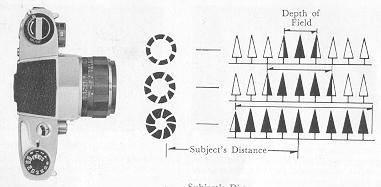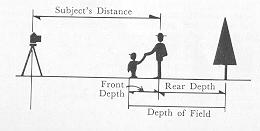If you find this manual
useful,
how about a donation of $3 to:
M. Butkus, 29 Lake Ave.,
High Bridge, NJ 08829-1701
and send your
e-mail address
so I can thank you.
Most other places would charge
you $7.50 for a electronic copy
or $18.00 for a hard to read Xerox copy.
This will help me to continue to host this site,
buy new manuals,
and pay their shipping costs.
It'll make you feel better, won't
it ?
If you use Pay Pal, use the link below.
Use the above address for a check, M.O. or cash.
I also have a 5 part,
very nice PDF Repair Manual.
Please write to me.
Miranda Sensorex manual PDF
from original manual
Miranda Sensorex other languages
Miranda Sensorex Mode d'emploi
Miranda Sensorex instrucciones
Miranda Sensorex Bedienungsanleitung
Click here to continue to
Miranda Sensorex PDF
manual made from this page
Better printing

We thank you for selecting our MIRANDA Sensorex as your companion and hope that it gives you much pleasure and satisfaction for
a long time to come.
As the pioneer of single-lens reflex in Japan and as a specialized manufacturer of this type of camera, the Miranda Camera Company
has been continually developing its products with new ideas and great originality.
MIRANDA Sensorex which has become your companion from today offers a new standard for quality cameras. It provides the advantage
of through-the-lens light measuring at open aperture, closed aperture or through selective spot or average reading, and is equipped with a lens of an
extremely high resolution, a bright and easy-to-use viewfinder. With a wide interchangeability of both viewfinders and lenses, and distinctive features
found only on high grade cameras, it rightly deserves being called the perfect SYSTEM CAMERA.
It has, moreover, a built-in self-timer, an almost noiseless shutter and vibration-free mirror mechanism, a compact
easy-to-hold body, and a complete line of convenient accessories to suit all occasions.
We firmly believe that it is able to meet any requirements of the amateurs or professionals.
Before taking your first picture, however, we earnestly advise you to read this Manual carefully as it would enable you to make best
use of the remarkable capabilities of this MIRANDA Sensorex Camera.
CONTENTS
|
I. Name of Parts
2. Special Features of MIRANDA Sensorex
3. Outline of Camera Operation
4. Film Loading
5. How to Use Film Advance Lever
6. Setting the Shutter Speed
7. Setting the Lens Aperture
8. How to Use Cds Meter
9. Automatic Diaphragm and Depth of Field Preview Lever
10. Quick-Return Mirror
11. Picture Composition and Viewfinders
|
12. Adjusting the Focus
13. How to Hold Camera and Press Shutter Button
14. Shooting at Slow Speeds
15. Self-Timer Operation
16. Shooting with Flash
17. Film Rewinding
18. Depth of Field
19. Lens Interchanging
20. MIRANDA Interchangeable Lenses
21. MIRANDA Sensorex Accessories
22. MIRANDA Sensorex technical data
|


SPECIAL FEATURES OF MIRANDA SENSOREX
 |
1. The
Superb 50mm fl.8 AUTO MIRANDA Len
AUTO-MIRANDA 50mm f/l.8 lens is a fully automatic diaphragm lens embodying Miranda's highest technique and enjoying the highest
reputation in all parts of the world It is a large aperture Gauss type lens of 6-element 4-group construction, which gives sharp
definition even at wide open aperture and is totally free of any focus-shift at the smallest aperture. Moreover, as it is perfectly
corrected for aberrations, it yields sharp images of the main subject and makes it therefore most suitable for color pictures.
|
 |
2. AUTO Miranda 50mm f
1.4
A new high speed 50mm fI.4 standard Auto Miranda lens has been developed for use on the Miranda Sensorex. It is a
gauss type lens, consisting of 8 elements in 6 groups, diaphragm calibrations from 1.4-I 6, minimum focusing
distance is 43 cm or 17 inches. Angle of view is 45°. It is advisable to use a lens hood with this lens to avoid reflection on
the front element.
|
 |
3. Instant-Return Mirror
One of the advanced features of the MIRANDA Sensorex is the instant-return mirror. When the shutter
release button is pressed, the mirror swings up, permitting the light rays from the lens to reach the film as the focal plane
shutter opens. Immediately after the film is exposed, the mirror returns to the viewing position. When the mirror is up, the view
through the viewfinder is momentarily blacked out, but, at speeds of I/I 5 second and faster, the mirror returns to the
viewing position so quickly that the photographer hardly notices the interruption.
|
 |
4. Convenient Interchangeable
Viewfinder
For an SLR system to manifest its fullest capacity, it is absolutely necessary that its viewfinder be interchangeable with
other types. MIRANDA Sensorex has this capability. For close-up, copying and low-angle shooting, its penta-prism viewfinder can
be interchanged with three types of viewfinders. Selective use of these viewfinders assures utmost convenience in taking
pictures of special effects under all conditions.
|
 |
5. Variable CdS Sensing Area
The CdS sensing area is positioned behind the mirror right in alignment with the optical axis, for precise light reading.
The sensing area occupies only 5% of the mirror.
|
 |
6. Unique Type of Lens
Mount
The lens mount of MIRANDA Sensorex has on its outside a 4-claw bayonet mount and on its inside a thread mount of 44mm inner
diameter (All MIRANDA cameras and lenses have the same standard lens mount).
The bayonet mount is for attaching the auto lenses (having automatic diaphragms) extension bellows, etc., quickly and easily by
merely giving I/8 of a full turn after mounting. The inner thread mount is for preset lenses and most of other accessories.
As the Miranda mount has a wide diameter and a short flange back (distance between lens attaching plane and film surface), it
permits the use of most lenses made for other SLR cameras by means of Miranda adapters. |
 |
7. Bright, Easy-to-View
and Accurate Viewfinder
MIRANDA Sensorex is equipped with a penta-prism viewfinder which shows the subject's image right side up and right way round.
It was Miranda Camera Company which first developed and adopted this system in Japan. It was Miranda also which first perfected a method
of improving the penta-prism's eyepiece to permit easier viewing.
Miranda's viewfinder accurately shows the actual image and background blurs exactly as transferred to the film, and is
therefore most useful in portraits, close-ups, copying and color shots, and particularly when shooting with telephoto lenses or
through the microscope |
 |
8. Complete Line of Interchangeable Lenses and Accessories
MIRANDA Sensorex is one of the highest grade SLR cameras embodying many outstanding features within its compact easy-to-use
body, but furthermore, it is provided with 19 interchangeable lenses ranging from 25mm to 800mm focal lengths, along with a full
assortment of useful accessories to make it deserve being called the full-scale System Camera. Besides ordinary shooting, it boasts of
remarkable versatility in close-ups, copying and photomicrography in the fields of science, medicine, industry, education and other
activities. |
OUTLINE OF CAMERA OPERATION

1. Open the back cover
While pressing lock button pull up clip lever at ton to open back cover.
|

2. Load the film
Insert film cartridge, with the spool projection facing down.
|

3. Set the ASA speed indicator
|

4. Wind film advance lever
Continue winding until film counter shows figure " 1 ".
|

5. Set the lens selector dial and turn on the meter switch
|

6. Obtain exposure by looking through viewfinder
While looking through the viewfinder turn shutter speed dial or diaphragm setting lever until the needles coincide.
|

7. Adjust the focus
Turn focusing ring until the jagged glitter disappears from the center focusing spot.
|

8. Decide the composition by looking through viewfinder and gently press shutter button.
|
FILM LOADING
· Always load or unload the film in the shade. If no shade is available, do it in the shadow of your own body.
· Whenever possible, avoid loading and unloading in a dusty place or at the seaside where strong salty wind is blowing.
· When loading or unloading, take care not to touch the shutter curtains.
|
 |
|
The 35mm film is advanced through rotation of the sprocket and not by direct winding of the spool; therefore, the sprocket
must engage the film's perforation perfectly. To check whether the film is advancing properly, the rewind knob is first turned
slightly to take up any play in the film; then if the advance lever is wound the rewind knob should rotate. But if the rewind
knob fails to turn it indicates that the film is not properly loaded and requires reloading.
|
As soon as you have loaded the camera, be sure to adjust the ASA speed indicator (ASA 25--1600)
on the shutter speed dial to the ASA speed of the film you have loaded. Lift the shutter speed dial and rotate it until the required
ASA speed is opposite the indicator mark. Setting the ASA speed is essential to exposure determination since the ASA speed indicator is
cross-coupled to the meter needle in the viewfinder, along with the diaphragm and the shutter. If the ASA speed is not correctly set,
the built-in CdS exposure meter will not indicate correct exposure settings. |
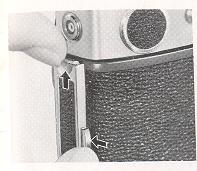
1. Open the back cover
Press lock button in the center of right edge of back cover and pull up clip lever at top at the
same time, which immediately opens the back cover. When back cover is opened, counter automatically returns to "S" (start)
mark.
|
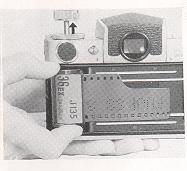
2. Insert cartridge into film chamber
Pull up rewind knob and insert cartridge, taking care that the projecting end of cartridge faces down.
|
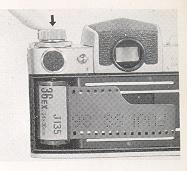
3. Push back rewind knob to original position
If the knob does not go all the way down turn it a little to the left or right.
|

4. Position take-up spool slit.
Turn the bottom knurled flange of take-up spool with a finger until slit appears.
|
5. Insert tip of film into spool's film slit.
Insert end of film making sure that one perforation is caught by the claw at the entrance of the film slit. Also see that the
sprocket engages the film perforation. |
6. Turn film advance lever until perforations on both sides of film are engaged by the
sprocket.
If one winding fails to make sprocket catch the perforations on both sides of the film, press shutter button and wind again. |

7. If film is advancing properly, close back cover.
Upon closing, push down clip lever, which will automatically engage the lock button and the back cover becomes
securely locked
|
8. Turn film advance lever several times to wind up the fogged portion of film.
Shoot several blanks and continue winding the film until film counter indicates ''I''. Then, slightly turn rewind knob in the
direction of arrow to take up any slack. |
9. When film counter indicates "1" it means film loading is completed.
From here, film counter will move e frame by frame for each shot to indicate the number of pictures which have been
taken.
|
TO USE FILM ADVANCE LEVER--

Before winding (WHITE)
|
Turn film- advance lever until it goes no further. One full turn of I80° is necessary to advance one frame. Insufficient winding
may make the shutter button unworkable, or even if it does work it may not permit proper opening of the shutter curtain. This
point requires careful attention.
One full winding also winds the shutter and changes the color in the signal window from
white to red. It returns to white again when 4 the shutter is released.
|
After winding (RED)
One full winding of film advance lever:
I. Advances one frame of film.
2. Makes film counter advance one number
3. Changes color in signal window from white to red.
4. Winds the shutter.
5. Sets the automatic diaphragm of lens and mirror mechanism.
|
SETTING THE SHUTTER SPEED-- 
|
To set the shutter speed, the shutter speed dial is turned to the left or right until the desired speed number lines up
with the shutter speed indicator. The dial rotates in either direction.
The marks "B. I, 2....... 1000" indicate" indicate Bulb, I sec., 1/2 sec ....... ...... 1/1000 1/1000 sec. shutter speed positions.
|
· The red "60" indicates the shutter speed for synchronization with electronic flash.
· Shutter speed can be freely changed before or after winding.
When turning the shutter speed dial, see that it falls correctly into click stop position. If set to intermediate positions, the
shutter will not operate at an accurate speed. |
APERTURE
|
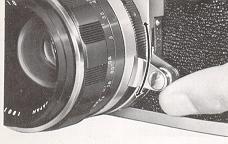
|
· Adjustment of the aperture scale to a point midway between the settings would give an
intermediate f-value.
· The aperture may be set either before or after film advance.
Because the diaphragm mechanism of the MIRANDA Sensorex is coupled to the metering system, refer to sections on the CdS exposure meter
and method of light measurement for further details on aperture setting. |
The aperture scale of the standard lens has calibrations from f/I.8 (I.4) to f/I6. To adjust
the aperture according to the light intensity, shift the aperture setting lever in either direction. The red indicator on the lens
mount or the diaphragm setting lever is used for reading the aperture setting.
· The larger the aperture value the less light is transmitted to the film plane. The calibration on the scale is arranged so that setting
to the next larger value reduces the volume of incoming light by half. If, there fore, the scale is adjusted in succession to the
next larger value, the volume of light transmitted through the lens would be decreased in progression of 1/2 I/4, I/8, 1/16 and so on. |
 |
How to Use the CdS Meter
1. Mercury Battery
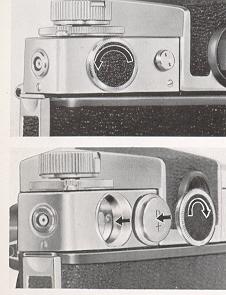 |
The CdS meter of the MIRANDA Sensorex is powered by a mercury battery. Before using your new Sensorex, therefore, load the mercury
battery which is supplied with it in the battery compartment of the camera.
I. Take off the battery compartment lid of the camera by turning it in a counterclockwise motion.
2. Place the mercury battery in the compartment, seeing to it that the (+) side faces the camera back, and close the lid.
3. The meter will be activated by turning on the meter switch.
· The meter will not function if the polarity of the mercury battery is reversed.
|
· Under ordinary circumstances, the mercury battery will provide sufficient power to work the meter over a duration of about two years. The
battery power declines sharply when it nears the end of its life-span, resulting in sluggish movement of the meter needle seen through the finder.
In this case, replacement of the mercury battery is necessary.
· When replacing the mercury battery, use Mallory # 625 or equivalent.
See this link on a Wein Air replacement battery.
· Remove the mercury battery from its compartment when the camera is to be left unused over any great length of time.
2. Setting the Film Speed
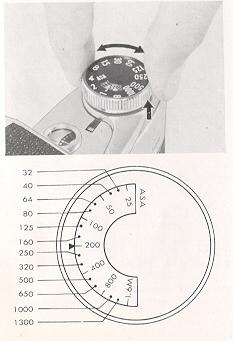 |
The CdS meter of the MIRANDA Sensorex is coupled to the film speed dial. After loading the film,
therefore, see that the film speed dial is set properly. Failure to adjust this dial according to the speed rating of the film loaded in
the camera will prevent the meter from giving correct exposure reading.
· Lift and turn the knurled outer ring of the shutter dial in either direction until the desired figure comes directly opposite the
indicator.
· It is unnecessary to re-adjust the film speed dial unless film of a different speed rating is loaded in the camera.
· The same film speed setting is employed when using filters or in close-ups and photomicrography.
· Intermediate settings on the dial denote film speeds given in the illustration. |
3. Switching on the Meter
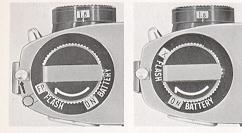 |
The CdS exposure meter is activated by pushing toward the camera front the meter switch
located on the base of the film rewind knob.
· The meter switch has click stop to prevent it from accidentally slipping out of position.
· The On/Off indicator is on the flash synchronizer selector.
Regardless of whether the flash synchronizer selector is set to FP or X, the indicator will show at a glance whether the switch is
turned on or off. |
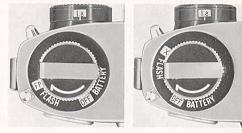 |
· Be sure to adjust the flash synchronizer selector accurately to the click stop settings at FP or
X. Failure to do so will prevent the On/Off indicator from giving the On or Off setting accurately.
· It is unnecessary to turn off the meter switch after each exposure; however, to prevent battery drain, it is advisable to
shift the lever to Off position when the camera is to be left unused.
|
4. Open Aperture Light Measuring
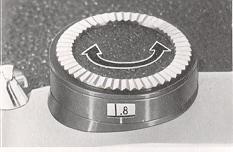 |
The MIRANDA Sensorex is the only camera in the world permitting open aperture light reading with either
exclusive Miranda lenses or other brands of preset diaphragm lenses. The method employed in light measurement is basically
the same with any of these lenses.
· The exposure computer system of the MIRANDA Sensorex is adjusted perfectly to the Auto-Miranda lens or other preset
diaphragm lens in use, simply by setting the lens selector dial on the camera front according to the maximum aperture of the
lens. If, for instance, a 50mm f/I.8 lens is mounted on the Sensorex, turn the dial until the figure I.8 appears in the window.
|
The lens selector dial has the following settings:
1.4 - 1.8 - 2.8 - 3.5 - 4 - 5.6 - 8
The CdS meter of the MIRANDA Sensorex is cross-coupled to the shutter speed and diaphragm mechanisms. Therefore, exposure is
determined according. to one of the following methods:
1. An appropriate shutter speed is pre-selected and the diaphragm setting lever is turned until the two needles in the finder are matched perfectly.
2. By pre-selecting the lens aperture, the meter needles are matched by turning the shutter speed dial.
3. In case of preset diaphragm lenses, the diaphragm setting lever is manipulated and the aperture reading where the two needles coincide is then
transferred to the aperture scale of the lens.
5.- Closed Aperture Light Measuring
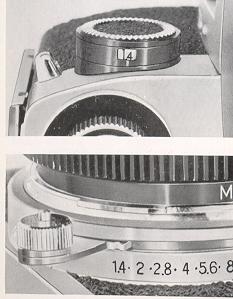 |
In ordinary situations, the open aperture light reading is more convenient as it enables bright
viewing of the subject area and also effectively provides against inaccuracy of light measurement resulting from strong backlight
entering through the viewfinder eyepiece. Nevertheless, closed aperture light reading is necessary in photomicrography or when
using lenses of undeterminable f-number.
The method of closed aperture light reading is identical with any type of lens used.
1. Adjust both the lens selector dial and diaphragm setting lever of the camera to f/1 .4.
2. Stop down the lens to the required aperture and match the needles by turning the shutter speed dial.
3. Take every precaution against backlight entering from the viewfinder eyepiece. Because the light transmitted through the lens
in case of closed aperture light reading is often weaker than the backlight, error in exposure reading is liable to occur. To prevent
errors in light reading, therefore, the use of the eyecup is recommended. |
6. Partial Average System
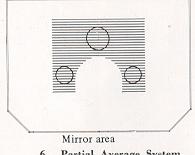 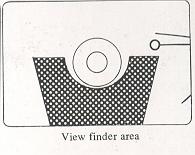
The Sensing area of the CdS meter of the Miranda Sensorex is placed behind the mirror in alignment with the optical axis of the lens in
use, always in position for exposure reading, except for the split second action of the mirror when taking a picture. |
The exposure meter measures an average of a part of the image, eliminating the light-influence
of the sky, which could cause over exposure of the picture, especially when color film is used. This light-measuring is
performed in a unique way. The single CdS-cell, behind the mirror, in actual fact is composed of 3 separate super sensitive light
measuring elements, positioned in the upper portion and left and right side of the mirror.
As the mirror is placed in the camera at a 45 degree angle, the reflected image in the viewfinder covers the area as shown in the
pictures. When photographing it is therefore a prerequisite to have the main subject in the area, covered by the exposure meter, |
7. Convenient, Efficient Cross Coupled Match-Needle System

The CdS meter incorporated in the MIRANDA Sensorex is of the match - needle type permitting speedy, accurate light measurement. It
is moreover cross-coupled to the shutter and diaphragm mechanisms. By looking through the viewfinder, you can see at a glance whether the
prevailing light is sufficient to guarantee correct exposure without extra adjustments. Moreover, since the meter is cross-coupled, light reading can
be done through pre-selection of either the shutter speed or lens aperture, depending on the method preferred by the user.
· Aim the camera toward the subject and while looking through the viewfinder turn the shutter speed dial or diaphragm setting lever until the follower
needle (with 0 on the tip) coincides with the meter needle.
This simple procedure enables accurate light measurement.
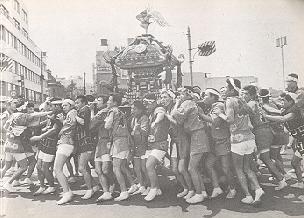 |
· To obtain special effect by doubling the exposure, match the upper curve of the O to the meter needle. To decease the
exposure by one setting, match the lower curve of the O to the needle.
· When in case of aperture pre-selection method the needles fail to coincide even when the shutter speed dial is turned, set
the shutter speed to the closest setting and then turn the diaphragm setting lever until the needles are perfectly matched.
Do not under any circumstances adjust the shutter - speed dial to an intermediate setting.
|
AUTOMATIC DIAPHRAGM AND DEPTH-OF FIELD PREVIEW LEVER.

· The fully automatic diaphragm of Miranda lenses is of special construction which keeps the lens wide open all the time to provide a very
bright viewfinder image for easy picture composition and speedy adjustment of focus.
· When the shutter button is pressed, the diaphragm automatically closes down to the aperture to which the lens has been set beforehand and makes it
work only at that aperture. But when the shutter closes, the diaphragm automatically reopens.
· The viewing can therefore be done at fully open aperture at all times. But if one desires to actually check the effects of a given aperture on the
image, the special lever on the lens barrel can be used. This preview ; lever when depressed stops down the diaphragm temporarily to the aperture
which has been pre-selected so that the depth of field and background blurs can be directly checked.
· Miranda's fully automatic diaphragm system is used not only in the standard 50mm lens but also in all other Auto-Miranda lenses. As with the
standard lens, they permit viewing at full aperture, no matter what f-stop has been pre-set for the actual shooting. In snapshots particularly, it
saves the trouble of having to open the aperture for focusing and to close it down for the shot.
· When changing the lens, it makes no difference whether the aperture is stopped down or not, for once it is mounted on the camera the aperture
automatically opens fully.

The mirror is of course of the quick-return type which causes an extremely short viewfinder black-out during shutter action. Due to
its original construction, the mirror mechanism on MIRANDA Sensorex is particularly quick acting and the viewfinder black-out at shutter speeds of
1/15 second or faster lasts no longer than the blinking of an eye.
· The coupled action between the automatic diaphragm and the mirror too is very smooth, so that when the shutter button is pressed:
(I) The diaphragm closes down to the preset aperture,
(2) Almost simultaneously the mirror swings up,
(3) Followed by opening of the shutter curtains and film exposure
(4) Then, the shutter closes, mirror returns to normal position and the lens diaphragm re-opens fully.
All the above actions are instantaneous.
PICTURE COMPOSITION AND VIEWFINDERS
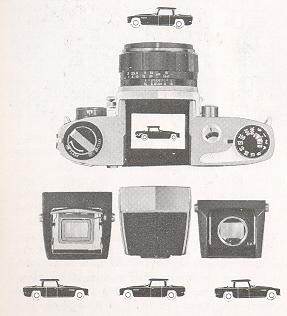 |
As the viewfinder of the SLR shows the very image which is formed by the taking lens, it is easy to check the relation
between the subject's perspective and its background, as well as the color tone effects when using color film, exactly as will be
exposed on the actual film.
MIRANDA Sensorex has a viewfinder of 0.92 magnification (with 50mm f/I.8 lens) and 95% coverage. The size of the picture is
intended to match the size of the color slide mount.
It also causes absolutely no parallax (difference between the area covered by the viewfinder and by the taking lens) not only
in ordinary shooting but, also in all types of close-ups.
|
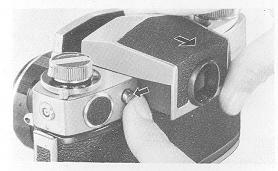 |
The viewfinder on MIRANDA Sensorex is interchangeable and can be changed with the most
convenient type according to the purpose of the shot so as to make best use of the camera's capacity. The v viewfinders available are
the pentaprism type and waist-level finders Types I and 3.
· For ordinary shooting it is convenient to use the pentaprism viewfinder which shows the image right side up and right way round.
· For low-angle or high position shooting and for candid shots, the waist-level finder VFI becomes useful; however, special care should
be taken to avoid light entering the camera through the focusing screen which may cause incorrect exposure.
· For close-up, copying and photomicrographic work, use critical focuser VF 3 . This viewfinder when collapsed turns into a I 5 times
magnifier for critical focusing at the center of the focusing screen. When opened it becomes a 5 times magnifier for inspecting
the entire picture area. |
The viewfinder on MIRANDA Sensorex is interchangeable and can be changed with the most convenient type according to the purpose of the shot so as to
make best use of the camera's capacity. The v viewfinders available are the pentaprism type and waist-level finders Types I and 3.
· For ordinary shooting it is convenient to use the pentaprism viewfinder which shows the image right side up and right way round.
· For low-angle or high position shooting and for candid shots, the waist-level finder VFI becomes useful; however, special care should be taken
to avoid light entering the camera through the focusing screen which may cause incorrect exposure.
· For close-up, copying and photomicrographic work, use critical focuser VF 3 . This viewfinder when collapsed turns into a I 5 times magnifier for
critical focusing at the center of the focusing screen.
When opened it becomes a 5 times magnifier for inspecting the entire picture area.
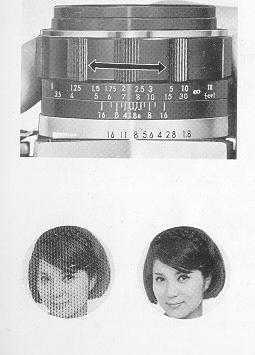 |
ADJUSTING THE FOCUS--
While looking through the viewfinder, if the focusing ring is turned either to the right or left it will, make the blurred
image of the subject become clear and sharply focused.
· The focusing is very easy as the viewfinder shows in its center a multi-microprism (collection of minute prisms). This
gives jagged edges to the image as soon as it is out of focus even in the slightest degree. Light is collected to the focusing
screen by means of a special system of fine-grained Fresnel lens and condenser, which permits bright corner-to-corner viewing.
|
Focusing for Infra-Red Shots
For infra-red shooting, first set to accurate focus in the normal way, then shift that distance reading to match the red "R" mark on the aperture
ring of the lens.
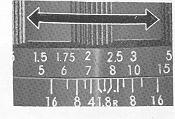
HOW TO HOLD CAMERA AND PRESS SHUTTER BUTTON
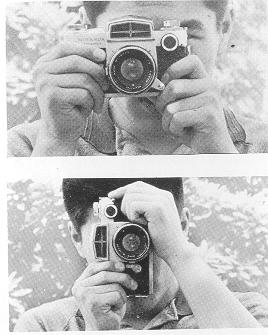 |
To obtain a sharp picture, the camera must be held properly. If there is camera shake, good pictures cannot be obtained even
with the best camera in the world. Whether shooting in the vertical or horizontal position, aim the camera at the subject
with the elbows pressed against the body if possible, but not too tightly, as this would stiffen the posture.
· Depress the shutter gently, while holding the breath for an instant.
· Do not press the shutter button with only the fingertip, but hold the camera between thumb and forefinger and press it as if
trying to squeeze the camera.
· Use the right eye to look into the viewfinder.
· When using telephoto lenses avoid camera shake by holding the lens barrel with the left hand. · Use a tripod when shooting at slow speeds.
|
SHOOTING AT SLOW SPEEDS
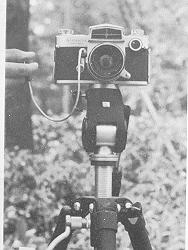 |
Hand-held shooting at speeds slower than I/30 second is liable to cause camera shake. In such a case. use a tripod when
possible preferably a sturdy kind.
When using a tripod it is better to work with a cable release, which can be screwed into the cable release socket on the
shutter release button. In slow speed shooting, make sure the shutter is completely closed before winding the film advance lever again.
|
SELF-TIMER OPERATION
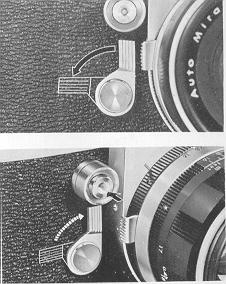 |
To use the self-timer, move the self-timer lever located on the front of the camera body 90 degrees to the left. It allows
you a time delay of approximately IO seconds after pressing the shutter release button. You may also get any intermediate time
delay- under IO seconds depending on the angle to which you set the lever. You may set the self-timer either before or after the
shutter is wound.
After setting the self-timer, if you decide not to use it, you simply have to return the lever to its original position,
and the self timer will be disconnected. The self-timer may be used very conveniently in place of a cable release. It will
release the shutter without any vibration.
|
FLASH PHOTOGRAPHY
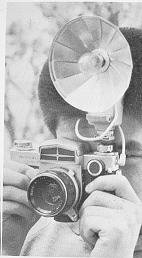 |
· For snapshots at night, in dark places, and in indoor shooting, flashbulbs or electronic flash
can be used to good
advantage. Flash units also provide auxiliary light for taking pictures of against-the-light subjects.
· For flash shooting, an exclusive flash Bracket is mounted to the bottom of the camera.
· The flash units is inserted from the rear of the flash bracket and secured by tightening its mount.
· Insert the plug of the flash unit into the camera's synchro terminal. For taking pictures with ordinary flash bulbs, turn the
selector dial to FP (focal plane).
· For taking pictures with electronic flash, turn the selector dial to X. When electronic flash is used the shutter speed must be set at
I/60 marked in red on the speed dial. For details, refer to the table on the next page.
· The F Class and M Class bulbs can also be used with slow shutter speeds (slower than l/30 see) but whenever possible use the FP Class
bulbs.
· Each type of flashbulb or electronic flash has a Guide Number to indicate its light output. Exposure should be calculated from these
guide numbers, The Guide Number is the product of "distance to subject" multiplied by the lens aperture value. From this
relationship, the correct lens aperture can be obtained by dividing the Guide Number with the "distance to the subject". |
-VARIOUS WAYS OF USING FLASH
As main light source
The flash unit is pointed towards to subject and exposure is determined by the exposure index attached to the flash unit.
Bounce light
This way of lighting diffuses the light evenly over the subject and surroundings is and obtained by flashing upwards, reflecting the light from
ceiling and walls. In this case the lens opening should be increased by 2 - 3 more Stops, due to a certain amount of loss of light.
Fill-in light
To be used for out door photography against the light, to avoid shadows in nearby subjects. No special precautions have to be taken as the fill-in
flash will not affect the exposure.
Combination Table for Flash Shooting

FILM REWINDING

1. First, the film rewind release button on the base of the camera body is pushed in until a small click is heard. This button need not be held
during rewinding. The film is now free from the sprocket which has been advancing it, and is ready for rewinding.
2. Flip the rewind crank on the rewind knob and wind in the direction of the arrow. At the end of the roll you will feel the resistance increase and then
suddenly cease. Turn the rewind crank several more times to make certain the film has been entirely rewound.
3.Open the back cover by depressing the lock button and pulling up the cover clip at the same time. Pull up the rewind knob and take out the film
cartridge.
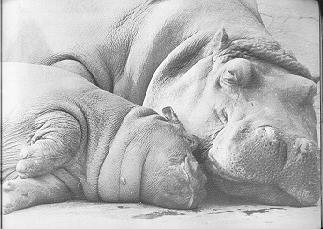
DEPTH OF FIELD.

no depth of field
depth of field
This is. the range that appears in sharp focus for any particular distance and diaphragm setting. There is relatively very little depth of
field where close-up subjects are focused on, and a great deal of depth of field in the case of more distant subjects. Closing the diaphragm down
increases the depth of field and opening the diaphragm reduces it. The depth of field also varies with the lens used. Wide angle lenses have great depth
of field while telephoto lenses provide lesser depth of held. If your picture is such that you want both nearby and distant objects to be in sharp
focus, then the smallest possible diaphragm should be used. However, very frequently the composition of a picture can be improved by having the
principal subject in sharp focus while giving a soft, out-of-focus effect on other objects in the scene. This will de-emphasize distracting background
objects and concentrate the viewer's attention on the principal subject.
HOW TO ASCERTAIN THE DEPTH OF FIELD

On the side of the lens barrel is the preview button. Pressing down this lever which is unrelated to the automatic diaphragm mechanism of the lens,
temporarily stops down the lens to the preset aperture. This permits ascertaining through the viewfinder the actual depth of field at that
aperture value.
This checking can of course be done more easily by magnifying the viewfinder's image. This applies particularly to copying. By interchanging
the camera's viewfinder with the critical-focuser VF3, the image can be viewed more critically through its high-power magnifier.
At the center of the lens barrel, facing up, is the depth-of-field scale which indicates the depth of field at a glance. The picture shows the focus
adjusted to 2 meters, indicating that the range in which sharp images can be obtained extend from 1.75 to 2.5 meters at f/8 aperture and about I .5 to 3 meters at f/ 16.
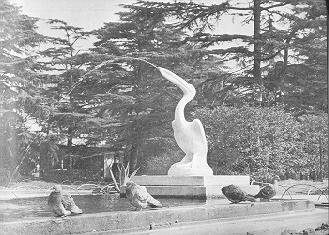
LENS INTERCHANGING
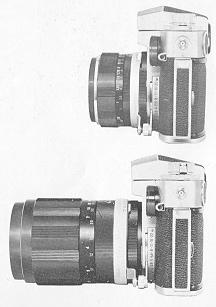 |
MIRANDA Sensorex has a bayonet type lens mount which permits quick lens interchanging and accurate coupling of the automatic
diaphragm mechanism of the lens.
Lenses can be interchanged regardless of whether the film is advanced or not. Moreover, it makes no difference what aperture
value the lenses may have been set at the time of changing.
For Miranda interchangeable lenses not belonging to the exclusive Auto-Miranda Series, such as Soligor or other preset
lenses, the inside thread mount can be used. Also various adapters and accessories can be attached by using either the
bayonet or the thread mounts.
|
Detaching the Lens
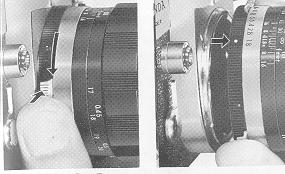 |
While pressing the lens lock lever on the side of the lens barrel, turn the lens counterclockwise l/8 of a full turn. When
the red dot on the barrel stops at the red line on the camera body, the lens comes off easily.
When attaching or detaching the lens, it is advisable to have the camera facing up on one's lap or other manageable place to
assure safe and correct handling.
· When changing the lens, take care not to let direct light enter the camera body.
|
Attaching the Lens
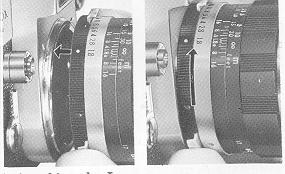 |
Match the red dot of the lens barrel with the red line on the body, fit the lens tightly and turn it clockwise l/8 of a full
turn. It will then click into position with the red dot exactly in the center.
· Be careful not to hold the helical portion of the lens (focusing ring section in front) when mounting the lens as the
focusing mechanism may be damaged.
|
MIRANDA INTERCHANGEABLE LENSES--
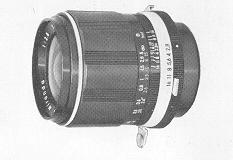 |
MIRANDA Sensorex has a number of extremely high resolution interchangeable lenses which embody the
latest optical theories and original designing. The Auto-Miranda lenses are of fully automatic diaphragm type, available in seven
types from 28mm to 200mm (mote in preparations), while the preset diaphragm lenses are available in 3 3 types from 25mm to 800mm. This
wide range permits selection of the most suitable lens for any purpose. The high resolving power and beautiful blurring effects, as
well as the perfect color balance, combined with light weight and easy use have made the Miranda lenses the most desired in the world. |
Auto MIRANDA 28mm f/2.8
A high speed, full-fledged ultra-wide angle lens, having great depth of field and no conspicuous distortion. Its brightness of f/2.8 exhibits its
fullest power in outdoor snapshots and architectural pictures, as well as in indoor and night scene shooting. It is made in a retrofocus formula.
Coverage angle 75°, lens construction 6 groups 8 elements, smallest aperture f/l6, closest focus at z5 centimeters, uses filters of 46mm
screw-in type, dimensions 57.5 x 60mm, weight is 230 grams.
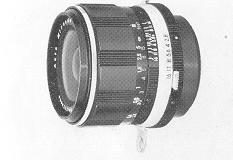 |
Auto MIRANDA 35 mm f/2.8
As a wide angle lens, this is the most popular type, causing least exaggeration of perspective and is very easy to use. This
is a versatile wide angle lens of f/2.8 brightness which is most suitable for night snapshots and indoor portraits. It is
a lens which should not be overlooked.
Coverage angle 63O, lens construction 5 groups 6 elements, smallest aperture f/I6, closest focus at 30 centimeters, uses
screwing filters of 46mm, dimensions 57.5x 47mm, weight is 195 grams.
|
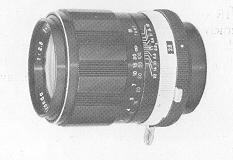 |
Auto MIRANDA 105mm f/2.8
A popular type telephoto lens which gives 2X magnified image as compared with the standard lens. It has nearly the same
coverage angle as the concentrated condition of the human eye and almost natural perspective, making it a versatile lens for
portraits, snapshots, landscapes and all types of subjects.
Coverage angle z3O, lens construction 3 groups 6 elements, smallest aperture f/22, closest focus at 1.2I'M meter, uses
screw-m filters of 46mm, dimensions 59 x 6g.4mm, which is 360 grams.
|
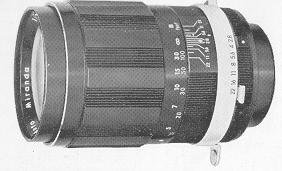 |
Auto MIRANDA 135mm f/2.8
The most popular and typical telephoto lens which should be added to increase the efficiency of MIRANDA Sensorex. It can
handle close-ups, portraits, stage photography, animal life and an endless variety of subjects. The size of the image is z.7
times larger than the standard lens.
Coverage angle 18°, lens construction 5 groups 5 elements, smallest aperture f/22, closest focus at I.7 meters, uses
screw-in filters of 55mm, dimensions 63 x g4.omm, weight is 49° grams.
|
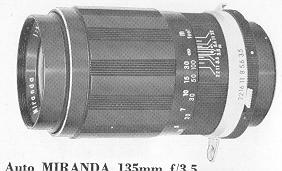 |
Auto MIRANDA 135mm f/3.5
Lightweight and easy-to-use telephoto lens. Brightness is slightly less than f/z.8 but has wonderful
resolution owing to its excellent designing. As f/3.5 brightness is sufficient for ordinary shooting, it shows good telephoto
effects in sports and portraits.
Coverage angle 18°, lens construction 3 groups 4 elements, smallest aperture, f/22, closest focus at 1.5 meters, uses
screw-in filters of 46mm, dimensions 59.7 x q4.omm. weight is 410 prams.
|
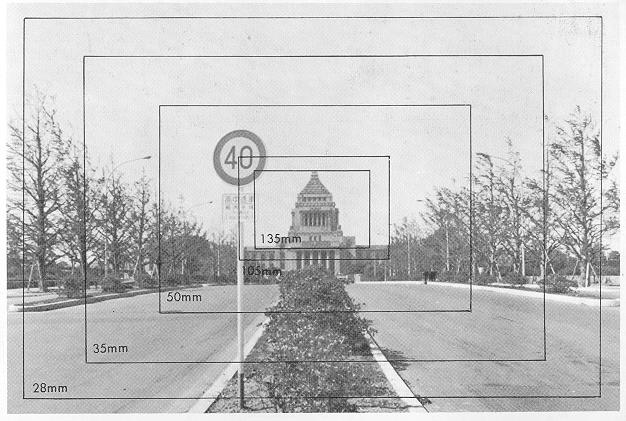
WIDEN YOUR PHOTOGRAPHIC SCOPE WITH MIRANDA'S LARGE RANGE OF
ACCESSORIES

A. Viewfinders
VF1 Viewfinder VF3 Viewfinder (5X) VF3
Viewfinder (15X)
As already explained briefly in connection with picture composition and viewfinder, the reflex finder differs from the pentaprism viewfinder, which
is used at eye-level, in being useful in taking pictures at waist-level. One of the special features of the MIRANDA camera is the interchangeability of
viewfinders. The interchangeable Miranda viewfinder system is far superior to the angle finder attachment used by other SLR cameras, as it permits
viewing of a bright and life-size image.
The viewfinder can be removed for interchanging by sliding it toward the rear, while pushing the viewfinder lock button to the left. To attach, match
the viewfinder's base to the camera's groove and slide it forward until it clicks into position.
C. Focabell
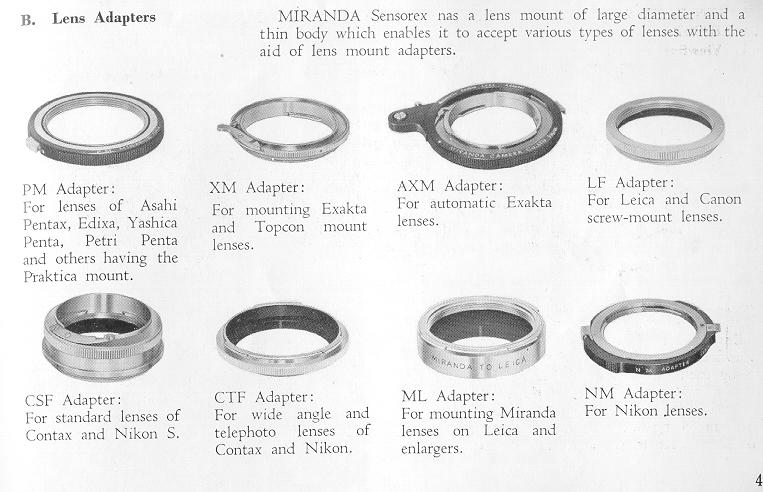 |
. |
This is an extension bellows unit which is used between the lens and camera body for taking ultra close-up shots and magnified pictures of small
objects. It is available in two types. It is attached to the camera in the same way as the lens by using the outside bayonet mount and matching to the
red line.
· The tripod socket of Focabell can be suitably shifted to obtain proper balance.
· When combined with the short-barrel Soligor 135mm f/3.5 lens, it becomes usable over a wide range of conditions from infinity
to ultra close-ups.
As the field of coverage can be easily varied it is extremely convenient in taking pictures of animal life and scientific works.
Focabell AII
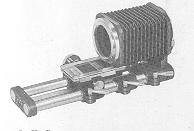 |
A deluxe type of extension bellows unit, double track and rack-and pinion for speedy movements
and a precision focusing device. |
Focabell S
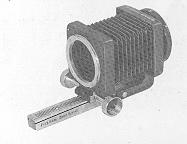 |
Foldable compact type with single track which is light and easy to carry.
· Pushing the lever on its right side permits the bellows to slide forward. Pulling it back locks the bellows firmly.
· Between the two tracks is a scale giving magnification ratios and exposure factors, black figures on one side for the
50mm lens and red figures on its reverse for the short-barrel Grimm lens. This scale can be detached by removing a screw and
re-attached to indicate the side which matches the lens being used.
|
· Magnification ratio is I~Z.6 times with 50mm lens and infinity to o.6 times with short-barrel I35mm lens. The figures on the scale show
magnification ratios at top and exposure at bottom.
· The magnification ratios are read off from the position indicated by the tip of the precision focusing device.
· Erect the track and lock it in position by moving the small button on the focusing knob side.
· The focusing knob is on the right side and the locking knob which is turned clockwise for locking the track is on the left side.
· The magnification scale on the left side is for o.g~z.5 times With the 50mmSomme lens, that on the right is for infinity to o.5 tulles with the
short-barrel r35mm lens.
· The magnification ratios can be read off from the position of the tip of the track guide, which slides through the side groove of the track.
D. Extension Tubes
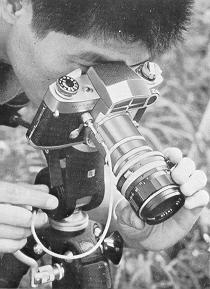 |
The standard lens of MIRANDA Sensorex gives sharp focus up to 45mm (17") (roughly 21 X I4cm fill up the entire viewfinder
field). But to shoot at closer distances, the extension tubes become necessary. Extension tubes are available in four lengths,
one AU Adapter and three intermediate rings. The AU Adapter is equipped with a screw and bayonet mount; the rings use the
inside thread mount.
The AU Adapter has the same length as Tube No. I.
The tubes are of lengths 8mm, 16mm and 3zmm, and can be used separately or in combination to give close-ups of O.I5~I.Z3 time
magnification.
· Magnification ratios and exposure factors are shown on the next page (for 50mmSomme lens at infinity).
· These are handy to use in copying photographs or taking
pictures of insect specimens.
|
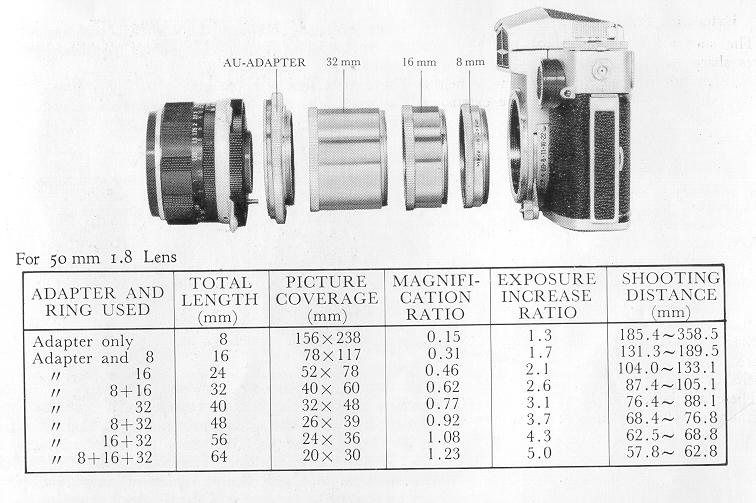
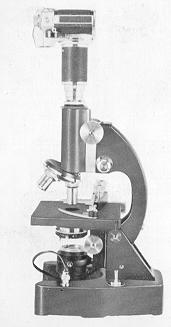 |
When mounted between the camera body and microscope, this adapter makes microscopic picture-taking extremely easy.
· The camera lens is taken off.
· The viewfinder may be interchanged with critical focuser VF3 for easier focusing.
How to Attach
(I) Attach adapter to camera body. (z) The connection piece at the end is turned counter-clockwise and detached. (3) Take
off microscope's eyepiece and attach it to the inside of the connection piece (Picture at left). r4) Insert into microscope's
eyepiece as before, match the red spots on tube and bayonet mount of connection piece, set to position to be used and
tighten the connection piece's screw (Picture at right).
|
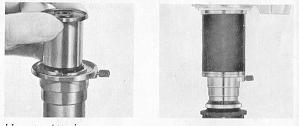
OTHER ACCESSORIES
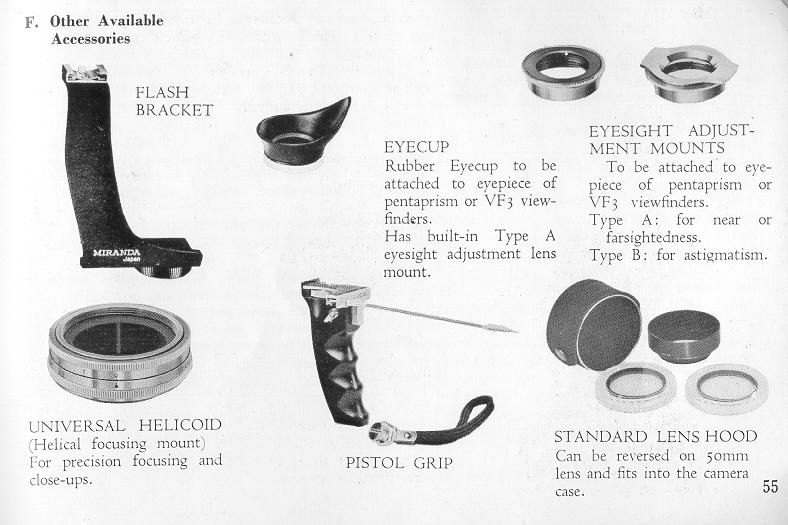
LENS: AUTO-MIRANDA 50mm f/I.8, 4-group 6-element or 50mm fI.4 6 group8 element Gauss type, spectra-hard coated, fully automatic diaphragm
coupled to through-the-lens CdS exposure meter, smallest aperture f/l6, preview lever, closest focus at 45cm (17"0 uses screw-in 46mm filter.
SHUTTER: Focal plane type, speeds of I -1/1000 sec., plus B.
FLASH SYNCHRO: FP 8t X (X at I /60th)
VIEWFINDER: Pentaprism, interchangeable with waist-level types, magnification 0.92X.(with 50mm f/I.8 at infinity), condenser and Fresnel
lens combined.
FOCUSING: Pentaprism with multi-microprism grid.
LENS MOUNT: Miranda Mount, bayonet and thread mounts.
LENS INTERCHANGEABILITY: Accepts Miranda as well as other automatic and preset lenses.
EXPOSURE: Through-the-lens CdS light measuring (I) at full aperture, (z) at closed aperture, or (3) through selective spot or average
reading, match-needle visible in the finder, measuring range EVI-I8(l4~(ASA 100) film speed range ASA Z5-I600, CdS sensing spot
in the center of the mirror, area of CdS sensor 5% of total mirror area, uses Mallory ~ 6z, mercury battery or equivalent.
FILM ADVANCE: Single or several short strokes of lever.
FILM REWIND: Rewind knob with collapsible crank, self-resetting release button
FILM COUNTER: Advance counting type with film wind (shutter winding) indicator.
OTHER FEATURES: Double exposure prevention, ASA speed indicator, lens speed selector with settings from f/I.4 to f/8, hinged back cover with
double safety self-locking device (entirely detachable from camera body).
SIZE: I46 x 94 x 86mm (thickness of body 52mm).
WEIGHT: w/50mm fI.8 1000 grams w/5omm fI.4 1100 grams Body only 6So grams
CARE AND STORAGE OF CAMERA--
When used on the beach, in strong wind or other unfavorable conditions, damage may be caused if left unattended, so please observe the following precautions:
CARE AFTER USE
· Clean the lens of dust and dirt by using a soft brush lightly, but do not clean too often.
· Use chamois or other soft material to clean the chrome plated parts.
Always use a blower to clean the mirror, which must never be touched with fingers.
PRECAUTIONS IN STORING
· Avoid places of high temperature or high humidity.
· Be careful to avoid shocks as they may cause damage.
· Keep the shutter unwound.
· Set the lens to infinity before closing the camera case.
· Be very careful not to drop the camera into salt water as repair may become Impossible.
· In case the camera is to be left unused for some time, pack it in a plastic bag together with a drying chemical and enclose it within a can or
other strong container to prevent damage.






















































